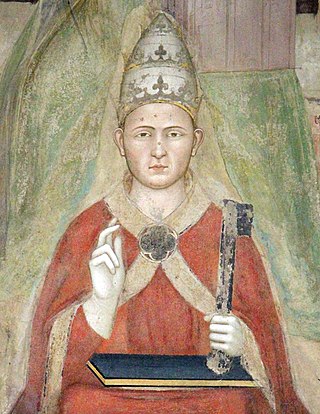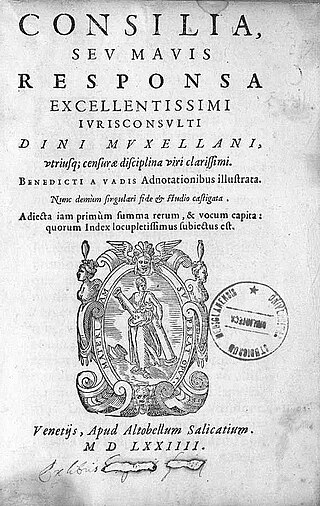Related Research Articles

Baldassarre Cossa was Pisan antipope John XXIII (1410–1415) during the Western Schism. The Catholic Church regards him as an antipope, as he opposed Pope Gregory XII whom the Catholic Church recognizes as the rightful successor of Saint Peter. He was also an opponent of Antipope Benedict XIII, who was recognized by the French clergy and monarchy as the legitimate Pontiff.

Pope Benedict XI, born Nicola Boccasini, was head of the Catholic Church and ruler of the Papal States from 22 October 1303 to his death, in 7 July 1304.

Pope Boniface VIII was the head of the Catholic Church and ruler of the Papal States from 24 December 1294 to his death, in 1303. The Caetani family was of baronial origin, with connections to the papacy. He succeeded Pope Celestine V, who had abdicated from the papal throne. Boniface spent his early career abroad in diplomatic roles.

Pope Clement V, born Raymond Bertrand de Got, was head of the Catholic Church and ruler of the Papal States from 5 June 1305 to his death, in April 1314. He is remembered for suppressing the order of the Knights Templar and allowing the execution of many of its members. Clement moved the Papacy from Rome to Avignon, ushering in the period known as the Avignon Papacy.

Giles of Rome O.S.A. was a medieval philosopher and Scholastic theologian and a friar of the Order of St Augustine, who was also appointed to the positions of prior general of his order and as Archbishop of Bourges. He is famed as being a logician, who produced a commentary on the Organon by Aristotle, and as the author of two important work: De Ecclesiastica Potestate, a major text of early-14th-century papalism, and De regimine principum, a guide book for Christian temporal leadership. Giles was styled Doctor Fundatissimus by Pope Benedict XIV.
Clericis laicos was a papal bull issued on February 5, 1296 by Pope Boniface VIII in an attempt to prevent the secular states of Europe, in particular France and England, from appropriating church revenues without the express prior permission of the pope. The two expansionist monarchies had come to blows, and the precedents for taxation of the clergy for a "just war" if it was declared a crusade and authorized by the papacy had been well established. The position of Boniface was that prior authorization had always been required and that the clergy had not been taxed for purely secular and dynastic warfare.

The diocese of Cagli e Pergola was a Roman Catholic ecclesiastical territory in the Marche, central Italy, in the province of Pesaro and Urbino. Up until 1563 it was under the direct supervision of the Roman pontiff. In that year, the diocese of Urbino was elevated to metropolitan status, and Cagli became a suffragan see of Urbino. The diocese was abolished as an independent entity in 1986, when it was incorporated into the diocese of Fano-Fossombrone-Cagli-Pergola. It was still a suffragan of the archdiocese of Urbino.

Berengar Fredol or Bérenger Frédol was a French canon lawyer and Cardinal-Bishop of Frascati.

Giacomo Gaetani Stefaneschi was an Italian cardinal deacon in the Catholic Church.
Giovanni Boccamazza was an Italian Cardinal. He was from the Roman nobility, and was a nephew of Cardinal Giacomo Savelli, who had been an important figure in the Roman Curia since his creation as cardinal in 1261.

Pierre de Luxembourg was a French Catholic prelate who served as the Bishop of Metz. He was made a cardinal of by an antipope, yet proclaimed "blessed" by the Catholic Church 140 years after his death.

The Diocese of Tivoli is a Latin Church ecclesiastical territory or diocese of the Catholic Church in Latium, Italy, which has existed since the 2nd century. In 2002 territory was added to it from the Territorial Abbey of Subiaco. The diocese is immediately exempt to the Holy See.

The Archdiocese of Chieti-Vasto is a Latin Church diocese of the Catholic Church which received that name in 1986, when the two separate dioceses, which had been governed by one and the same bishop, were united in one diocese. The diocese of Chieti had become the Archdiocese of Chieti in 1526, when promoted by Pope Clement VII. Chieti is about 8 miles (14 km) south-west of the Adriatic port city of Pescara.

The Archdiocese of Ferrara-Comacchio is a Latin Church archdiocese of the Catholic Church. It has existed since 1986, when the diocese of Comacchio was combined with the historical archdiocese of Ferrara. It is a suffragan of the archdiocese of Bologna.

Jean Lemoine, Jean Le Moine, Johannes Monachus was a French canon lawyer, Cardinal, bishop of Arras and papal legate. He served Boniface VIII as representative to Philip IV of France, and founded the Collège du Cardinal Lemoine, in Paris. He is the first canon lawyer to formulate the legal principle of the presumption of innocence.

Dinus de Rossonis or Mugellanus was an Italian jurist of the late 13th century.

The 1304–1305 papal conclave was initiated after the death of Pope Benedict XI in July 1304. The conclave took place in Perugia, the city in which Benedict had died, and proved to be a protracted affair. It ran from 10 or 17 July 1304 to 5 June 1305, and ultimately elected the non-cardinal Raymond Bertrand de Got as Pope Clement V. At the time of his election de Got was Archbishop of Bordeaux, and thus a subject of Edward I, King of England, although he was a childhood friend of Philip IV of France. Clement V's decision to relocate the papacy to France was one of the most contested issues in the papal conclave following his 1314 death, during which the minority of Italian cardinals were unable to engineer the return of the papacy to Rome. This immediately preceded the beginning of the Avignon Papacy.
Pedro Rodríguez de Quexada or Petrus Hispanus was an ecclesiastic from Castile.
Landolfo Brancaccio was a Neapolitan aristocrat, friend of King Charles II of Naples, and Roman Catholic Cardinal.
Guido Sette (1304–1367/68) was the archbishop of Genoa from 1358 until his death. He was a close friend of Petrarch.
References
- 1 2 3 4 5 6
 One or more of the preceding sentences incorporates text from a publication now in the public domain : Gans, Leo (1907). "Guido de Baysio". In Herbermann, Charles (ed.). Catholic Encyclopedia . Vol. 2. New York: Robert Appleton Company.
One or more of the preceding sentences incorporates text from a publication now in the public domain : Gans, Leo (1907). "Guido de Baysio". In Herbermann, Charles (ed.). Catholic Encyclopedia . Vol. 2. New York: Robert Appleton Company. - ↑ see Ferraris, Bibliotheca, (Rome, 1892), VIII, 271.
- ↑ Strasburg, 1472; Rome, 1477; Venice, 1480; 1513; 1601, etc. The "Apparatus ad Sextum", Milan, 1480; Venice, 1577.
- ↑ Thomas M. Izbicki, "Guido de Baysio's Unedited Gloss on Clericis laicos," Bulletin of Medieval Canon Law 13 (1983): 62–67.
- ↑ It is published in Mansi, "Coll. Sacr. Concil.", XXV (Venice, 1782), 415–426.
- Johann Friedrich von Schulte, Geschichte der Quellen u. Litteratur des kan. Rechts (Stuttgart, 1875), II, 186–190
- Hugo von Hurter, Nomenclator (Innsbruck, 1899), IV, 413
- Scherer in Kirchenlex., II, s. v.